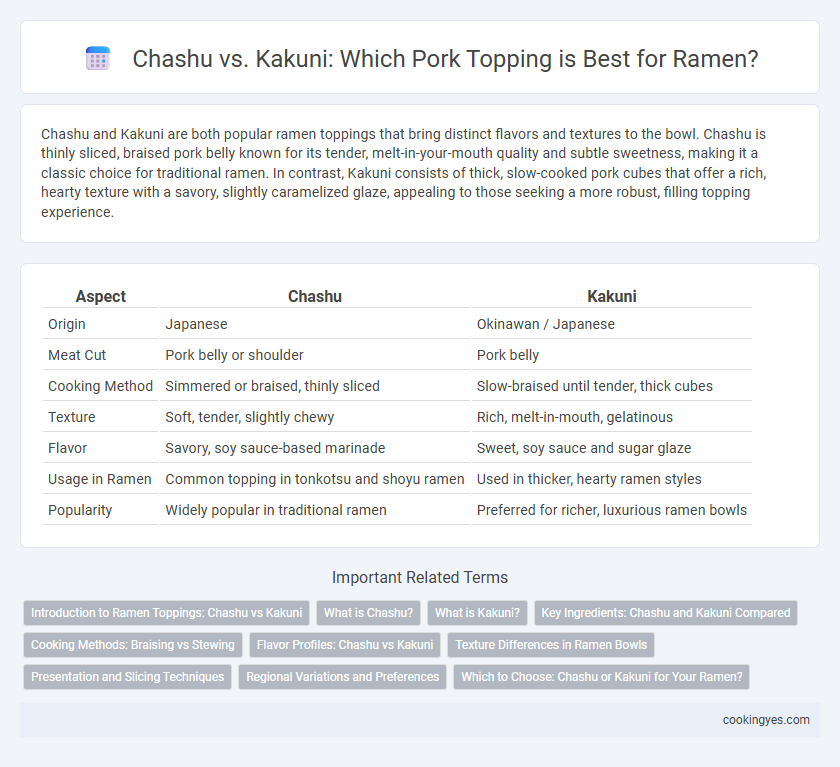Chashu and Kakuni are both popular ramen toppings that bring distinct flavors and textures to the bowl. Chashu is thinly sliced, braised pork belly known for its tender, melt-in-your-mouth quality and subtle sweetness, making it a classic choice for traditional ramen. In contrast, Kakuni consists of thick, slow-cooked pork cubes that offer a rich, hearty texture with a savory, slightly caramelized glaze, appealing to those seeking a more robust, filling topping experience.
Table of Comparison
| Aspect | Chashu | Kakuni |
|---|---|---|
| Origin | Japanese | Okinawan / Japanese |
| Meat Cut | Pork belly or shoulder | Pork belly |
| Cooking Method | Simmered or braised, thinly sliced | Slow-braised until tender, thick cubes |
| Texture | Soft, tender, slightly chewy | Rich, melt-in-mouth, gelatinous |
| Flavor | Savory, soy sauce-based marinade | Sweet, soy sauce and sugar glaze |
| Usage in Ramen | Common topping in tonkotsu and shoyu ramen | Used in thicker, hearty ramen styles |
| Popularity | Widely popular in traditional ramen | Preferred for richer, luxurious ramen bowls |
Introduction to Ramen Toppings: Chashu vs Kakuni
Chashu and Kakuni are popular ramen toppings that enhance the dish's flavor and texture distinctly. Chashu is a thinly sliced, braised pork belly marinated in soy sauce, mirin, and sake, offering a tender and savory taste. Kakuni, on the other hand, is thick, slow-braised pork belly, rich and fatty with a melt-in-your-mouth texture, providing a heartier complement to ramen broth.
What is Chashu?
Chashu is a traditional Japanese ramen topping consisting of thinly sliced braised pork belly, marinated in soy sauce, sake, mirin, and sugar to achieve a tender texture and rich umami flavor. It differs from kakuni, which is typically thicker, chunkier pork belly simmered for extended periods until meltingly soft. Chashu's delicate balance of savory and slightly sweet notes enhances the overall ramen experience by complementing the broth without overpowering it.
What is Kakuni?
Kakuni is a Japanese braised pork belly known for its tender texture and rich, savory flavor, achieved by slow-cooking pork in a mixture of soy sauce, sake, mirin, sugar, and ginger. Unlike Chashu, which is typically rolled and roasted pork belly, Kakuni is simmered for hours until the meat becomes melt-in-your-mouth soft and infused with a deep umami taste. This makes Kakuni a hearty and flavorful ramen topping, offering a distinct richness that complements the broth's complexity.
Key Ingredients: Chashu and Kakuni Compared
Chashu is a Japanese-style braised pork belly known for its tender texture and subtle soy-based marinade, often containing mirin, sake, and sugar, which imparts a delicate sweetness to ramen. Kakuni, originating from Okinawan cuisine, features pork belly cooked slowly in a rich mixture of soy sauce, sugar, sake, and sake lees, resulting in a melt-in-your-mouth texture with a robust, caramelized flavor. Both toppings enhance ramen by adding savory depth, but Chashu offers a lighter, mildly sweet profile, while Kakuni delivers a deeper, more intense umami experience.
Cooking Methods: Braising vs Stewing
Chashu is traditionally prepared through braising, where pork belly is slowly cooked in a mixture of soy sauce, sake, and sugar, allowing the meat to absorb rich flavors while maintaining a tender texture. Kakuni, on the other hand, is stewed for a longer duration in a seasoned broth, resulting in a melt-in-the-mouth consistency with a more gelatinous texture due to prolonged simmering. The contrasting cooking methods impact the meat's texture and flavor profile, with chashu offering a slightly firmer bite and kakuni presenting a deeply infused, soft, and succulent topping for ramen.
Flavor Profiles: Chashu vs Kakuni
Chashu offers a tender, mildly sweet flavor profile with a delicate soy-based marinade that enhances the umami taste of the pork belly, making it complement lighter ramen broths. Kakuni features a richer, more robust flavor with its braised pork belly simmered in soy sauce, sake, and sugar, resulting in a melt-in-your-mouth texture and a deep, savory sweetness that pairs perfectly with thicker, heartier ramen styles. Both toppings contribute unique savory depths but differ significantly in their preparation methods and intensity of flavors.
Texture Differences in Ramen Bowls
Chashu, a braised pork belly, offers a tender and slightly fatty texture that melts effortlessly in ramen broth, enhancing the richness of each bite. Kakuni, a slow-simmered pork belly, features a firmer yet succulent texture with a gelatinous layer that provides a chewy contrast and a deeper umami flavor. The choice between Chashu and Kakuni significantly influences the mouthfeel of ramen, balancing softness with a satisfying bite.
Presentation and Slicing Techniques
Chashu is typically thinly sliced pork belly, rolled and braised to achieve a tender texture and uniform, circular presentation that easily melds with ramen broth. Kakuni, on the other hand, involves chunkier, cube-like cuts of pork belly slowly simmered until soft, highlighting a rustic, hearty look with a melt-in-the-mouth consistency. The precise slicing of Chashu emphasizes delicate layering atop ramen, while Kakuni's larger pieces create a bold, textural contrast within the bowl.
Regional Variations and Preferences
Chashu, braised pork belly thinly sliced, is a staple ramen topping prominently favored in Tokyo-style ramen, known for its tender texture and savory flavor. Kakuni, a cubed, slow-braised pork belly originating from Kyushu, offers a richer, melt-in-the-mouth taste preferred in Hakata and other southern ramen varieties. Regional preferences highlight Chashu's versatility across various broth styles compared to Kakuni's hearty profile, reflecting local culinary traditions and texture preferences in ramen toppings.
Which to Choose: Chashu or Kakuni for Your Ramen?
Chashu, a thinly sliced, braised pork belly with a savory soy-based marinade, offers a tender texture and rich umami flavor that melds perfectly with ramen broth. Kakuni features thick, slow-cooked pork belly chunks that are melt-in-your-mouth soft with a slightly sweet and savory glaze, adding a hearty depth to each bite. Choosing between Chashu and Kakuni depends on whether you prefer a delicate, balanced topping or a robust, indulgent meat experience in your ramen bowl.
Chashu vs Kakuni for ramen topping Infographic

 cookingyes.com
cookingyes.com